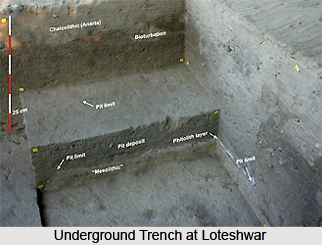 Loteshwar is an interesting archaeological site which is a part of the Indus Valley Civilization situated in Mahesana District, Gujarat, and is also referred to as `Khari-no-Timbo`. It is present over a high sand dune on the left banks of Khari Nadi, which is a tributary of Rupen River. Archaeological evidences indicate that Loteshwar was inhabited by human populace since 6th millennium BCE by primitive hunter gatherers and within 4th millennium BCE, which witnessed the existence of goat and sheep here. During the period from 1990 to 1991, excavations were conducted by the Department of Archaeology and Ancient History of the M.S. University, Baroda. Artefacts belonging to cultural periods of Period I consisting of monolithic culture and Period II which bears a resemblance to the Harappan culture have been discovered from this part of the country.
Loteshwar is an interesting archaeological site which is a part of the Indus Valley Civilization situated in Mahesana District, Gujarat, and is also referred to as `Khari-no-Timbo`. It is present over a high sand dune on the left banks of Khari Nadi, which is a tributary of Rupen River. Archaeological evidences indicate that Loteshwar was inhabited by human populace since 6th millennium BCE by primitive hunter gatherers and within 4th millennium BCE, which witnessed the existence of goat and sheep here. During the period from 1990 to 1991, excavations were conducted by the Department of Archaeology and Ancient History of the M.S. University, Baroda. Artefacts belonging to cultural periods of Period I consisting of monolithic culture and Period II which bears a resemblance to the Harappan culture have been discovered from this part of the country.
Period I and Period II Findings at Lotheshwar
Various kinds of monolithic tools like hammer stones, grinding stones and flat sandstone palettes have been unearthed from the 60 cm deposit on sand dunes which belong to Period I. Such weapons were generally composed of quartz, chert, jasper and agate, and two burial sites have also been found. Deposits of about 80 cm marked the Period II culture but the deposits which were associated to human culture were existent only about 20 cm to 25 cm in thickness. Excavations have revealed the presence of several pits which measure about 0.5 to 2 metres in diameter and 0.5 metres to 2 metres in depth, contain remnants of potsherds, animal bones, ashy soil and many other materials. However, archaeologists are still unaware about the utility of so many pits.
Red-ware and gritty red-ware are amongst the main pottery objects found from this ancient site which are quite similar to those existent in Nagwada and polychrome and red-ware pottery-ware unearthed from Surkotada. Fine clay and well-fired red-ware potteries were present.
Artefacts Discovered at Loteshwar
Lumps of terracotta, coarse red-ware and grey-ware with engraved patterns, agate beads, `mushtika` lumps, carnelian beads, amazonite beads, steatite micro beads, pots and bowls adorned with white or creamy backgrounds, painted in shades of red and black are some of the numerable artefacts found in Loteshwar. Clay lumps, terracotta bangles, terracotta figurines are the other ancient objects found. A distinct Indian culture has been portrayed by the pottery items uncovered from Loteshwar, which is different from the Amri-Nal pottery crafts. The old ceramics excavated from this region are distinct from those belonging to the Harappan phase and suggest that pottery-ware were manufactured here. Funeral remnants of cattle, sheep, goat, turtle and fish have also been discovered from Loteshwar.



















